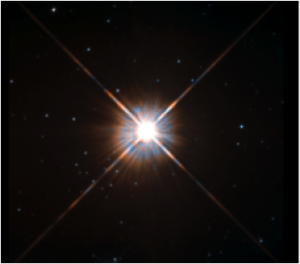Have you ever been looking at the sky at night and seen what you thought was a blinking star? It probably only took a moment or two for you to recognize that it was the navigation lights on an airplane.
Of course in the summertime, when the air is laden with moisture and tumultuous, hot and cold air masses crash together and swirl, so we see the stars twinkle. It’s much less like that in the wintertime when the cold, dense, and steady air is much more stable and makes the stars look like hard little points of light that barely twinkle at all.
Except for the Sun, all the stars are so distant that the tiniest little bit of disturbance in the atmosphere will scatter their light. In fact to the casual observer, that’s the best way to identify when you’re looking at one of the planets in our solar system. Planets never twinkle because they’re reflecting so much light, over such a short distance (compared to a star) that our atmosphere can’t affect them significantly.
Getting the message out
But let’s say that you wanted to communicate with another star. How would you go about it? We are getting very good at isolating planets surrounding other stars. We’ve actually found some that are Earth-sized, and look like they have water. Fantastic news!

We now know that, much like the planet Tatooine of Star Wars fame, it is possible for binary or trinary star systems to have planets. It even looks like our nearest neighbor, Proxima Centauri, has an interesting planet.
So how would we send a message? Yes we could send a radio signal, but that requires that these potential neighbors have an antenna set up, ready to receive, and set to the right frequency. Isn’t there something that might be easier to do and more difficult to miss? Oh yes there is!
Laser, laser, burning bright…
If you’ve ever accidentally caught a glimpse of a laser pointer from across the room you know how insanely bright they appear. Those are typically very poorly focused (because people are careless and “accidentally” shine them at other people) and they usually have a power level of 5 milliwatts or less. Some SETI researchers have already done studies in this area, including one from the Astrophysical Journal, and another from Acta Astronautica.
These “observational” studies are not sending signals, but rather are looking at as much of the sky as possible, to see if any stars are flickering. They are looking for any unnatural pattern. My favourite is the blink-pattern 1, 2, 3, 5, 7, 11 (prime numbers, endlessly cycling).
We could send a signal with just a one watt purple laser delivering 2 × 1018 photons per second to any star within 10 light-years (which we could detect with our current instruments). Of course it would be against the background of our white Sun (sorry to disillusion you, but it’s not yellow, as often stated), so to help them see it we might choose a laser color like purple (400 nm), blue (475 nm), or green (530 nm) but probably not yellow (580 nm), orange (600 nm) or red (700 nm) since atmospheres tend to block up to 20% of that part of the spectrum and make it much harder to observe.
If we confine ourselves to systems within 10 light years, our current best technology should be able to confine the beam to 160 kilometres across (100 miles) or less. So since we know where the target star is, and we have a good idea of where the target planet is, we should be able to hit them with the equivalent of a brilliant spotlight of collimated, pure, monochromatic light.
Efficient Delivery

Most every star has an ideal distance where the insolation (energy received from the star) will not boil off all of the water (red area), or freeze in it to a solid state (blue area). We call this the Goldilocks Zone (GLZ, the area in purple). In our solar system that area would include Mars and Earth, both home to liquid water.
Of course, I propose we don’t use our best technology and a 1 watt laser. We should craft the beam, so that it is doughnut-shaped and large enough to cover the entire GLZ with a custom-built megawatt device. Or we could cover the GLZ with a commercial 500 watt laser, a slice at a time to focus more power, and make sure we didn’t miss an undetected planet.
More importantly, such powerful lasers would not require high tech photomultiplier telescopes to be seen. A short enough high-powered pulse could effectively make our Sun appeared to double in brilliance momentarily. It would be as obvious to a casual observer as blinking lights on an airplane are to you.
What would you do if you were looking at the constellation Leo and noticed that the star Wolf 359 (a mere 7.7 light years away) was going blink… blink blink… blink blink blink… blink blink blink blink blink… blink blink blink blink blink blink blink… You would probably mention it to someone, wouldn’t you?
While it’s entirely possible that on the entire planet no astronomer happened to be observing Wolf 359, it would be almost impossible that a casual observer somewhere on the planet would not see it.
The Takeaway
It’s certainly not hopeless to look for radio signals from the sky. Radio offers a number of possibilities looking at a very broad area. Once a signal is isolated we can focus very intently on a particular portion of the sky and find out all sorts of interesting things about that signal.
High intensity signaling by light might be seen by someone lying casually on a hillside regarding the night sky, but human eyes aren’t necessary with new automated observations. Those done by the Astrophysical Journal and Acta Astronautica demonstrate that the process can be automated.
Maybe it’s time for us to start signaling a few of our closest neighbors and see if anyone is home. Just because it is a long distance relationship doesn’t mean that it won’t work out…